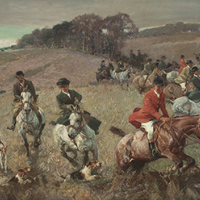H. SEPTIMUS POWER A Fox Hunt in the Midlands

Harold Septimus Power returned to Australia in early 1913, having spent a number of years studying at Academie Julian, Paris, followed by a lengthy sojourn in England. His first solo exhibition opened in Melbourne in June, on a Friday 13th – 1913! Apparently it was not an unlucky day for the artist, as sales totalled over £3,000 during the three-week showing. A month or so later the National Gallery of Victoria purchased The Stag Hunt, Exmoor, Full Cry for £200. The highlights of the exhibition were the National Gallery’s acquisition and Fox Hunt in the Midlands, being catalogue numbers one and two, and similarly priced. Both were exhibited at the London Royal Academy in 1911 and 1912 respectively. In Melbourne, these two paintings aroused much favourable press. The art critic for The Age, commenting on Power’s ‘individual manner of conception’, singled out the latter painting for special praise: ‘it is seldom… that the impression of spirited action is so adequately conveyed as in A Fox Hunt in the Midlands… a breezy example, full of motion, and a sense of the excitement of the chase.’1 The Argus reviewer was equally full of praise: ‘In another canvas, dealing with the chase, Fox Hunt in the Midlands, the field in full cry is coming full tilt at the spectator, and one can almost hear the movement and breezy dash of the horsemen and hounds at the foreground fence.’2
This strong feeling of movement, captured in the wide sweep of the mounted riders, harmonises with the curves of the landscape, another area in which Power excelled. Characteristic moments of vigorous riding are expertly rendered, together with magnificent profiles of horses, contrasting with the headlong charge of physical beauty in action. The prominence of the red-coated huntsman in the right foreground speaks of the regality of this ancient sport in a gallant array of horsed, riders and hounds. Power’s command over colour and spirited endeavour was such that, later on, Arthur Streeton remarked: ‘One is impressed first by a tremendous display of colour and a dauntless feeling of optimism.’3
Septimus Power is widely regarded as Australia’s master painter of the horse, his subjects full of nobility and heroic endeavour. It labours in his rural landscapes and features valiantly in his cavalry paintings of World War I.
His ability was also recognised internationally. The very royal portrait, H.R.H. Prince of Wales, with the Hounds at Melton Mowbray, was the highlight of his 1936 exhibition. Then, two years later, America beckoned when he was commissioned to paint the Hollywood actress Betty Grable with her horse.
For a man once intent on being a vet he travelled a long road of success.
Footnotes
1. The Age, Melbourne 13 June 1913, p.11
2. Argus, Melbourne, 13 June 1913, p.6
3.
Streeton, A., ‘Optimism and Colour: Mr Power’s Pictures: Large Exhibition’, Argus,
Melbourne 24 May 1933, p.9
David Thomas